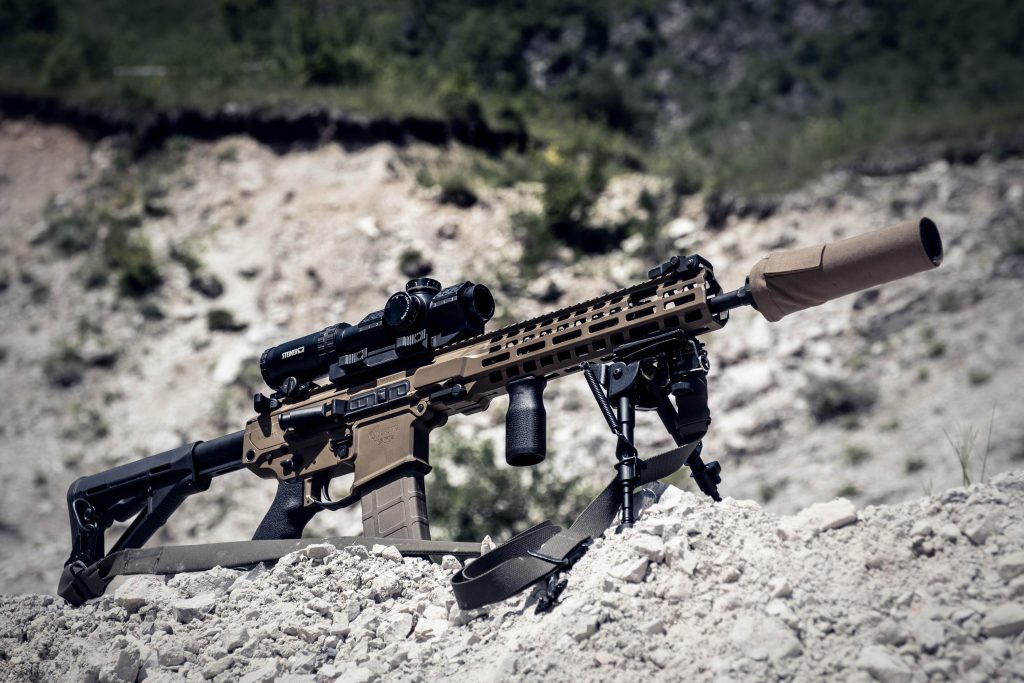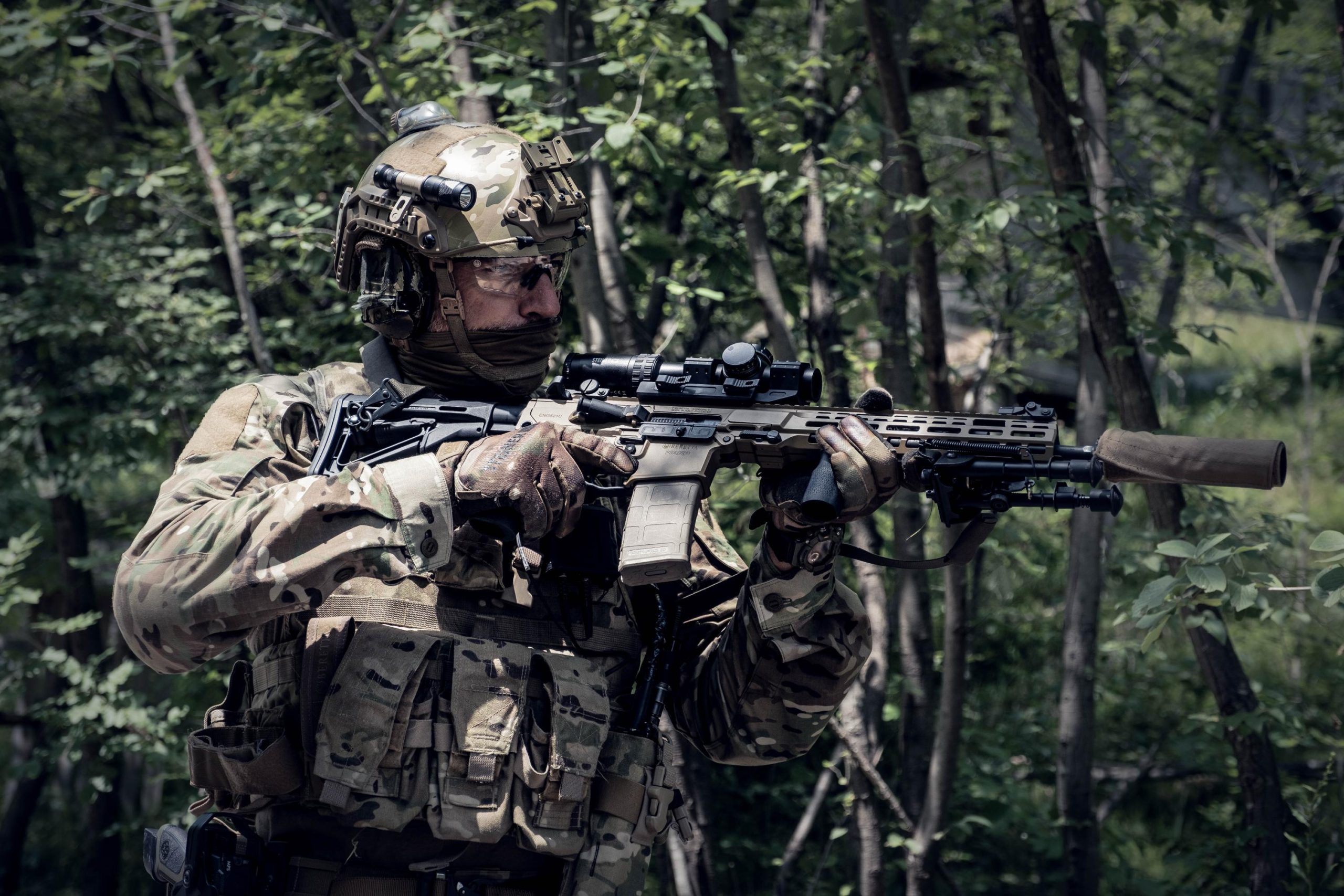Calibre interview: Jack Cadman, Beretta UK and Project Grayburn
The UK is looking to replace its Cold War era assault rifles under Project Grayburn. A number of companies are positioning themselves to meet the demand including Beretta. This Calibre Defence interview with Jack Cadman provides an insight into the company’s offering.
In 1994 the Royal Ordnance Nottingham Small Arms Factory, which was owned by British Aerospace at the time, produced the last of some 350,000 SA80 assault rifles for the British Armed forces. By 2001, the production line had been broken up, bringing domestic, end-to-end production of assault rifles to an end in the UK. By that time, the rifle had seen operational use in the Gulf War and Sierra Leone, earning a reputation for poor reliability and design snags amongst British troops. Eventually, an upgrade to the A2 standard was implemented by Heckler and Koch, leading to the reopening of the Nottingham factory and modernisation of 200,000 rifles between 2001 and 2006. The SA80A2 was tested extensively, firing tens of thousands of rounds without failure and proudly declared to be a leading assault rifle in its class that would equip the British Armed forces until a replacement was procured in 2015.
Ten years later than expected, the British MoD is finally implementing a project to replace its SA80 with Project Grayburn. Several companies are positioning themselves to address the need, and one of them is Beretta Defence Technologies (BDT) UK, an alliance of Beretta holding companies including Beretta itself, Benelli, SAKO, and Steiner – a provider of optics amongst others. Calibre met with Jack Cadman, manager of the Military and Law Enforcement Group of BDT UK, to learn more about the company’s offering for Project Grayburn.
Demand signals

Jack served in the UK’s Rifles regiment gaining operational experience of the SA80 family that Project Grayburn is expected to replace. Credit: BDT UK.
Jack was upfront and clear in what is needed from the British MoD for companies to come to the UK. “Grayburn I think is 180,000 weapons, it’s a big programme, but it’s not clear how that will be broken down and delivered. But, for us to go forward with Project Grayburn, we need to see what the intent is from the UK MoD,” he explained, referring to the requirement for weapons to be produced in the UK. Since the Nottingham Factory was first closed in 2001, the UK has not had the ability to produce assault rifles domestically at scale, maintaining only maintenance and overhaul facilities. Re-establishing these types of capability are now seen as strategic priorities that have bridged the gap between the previous Conservative government, and the current Labour one.
There will therefore be a strong drive for all of the Grayburn competitors to build the successful assault rifles in the UK, but that comes with a catch, back to Jack; “We know they would want to spend a certain amount per weapon system, but if they only want a low number of weapons AND they want them produced in the UK, then the costs will be high. So it will then depend on how much of the weapon system is produced in the UK. If there was a full demand signal – we can produce the weapon at the required cost – in the UK. But if they scale Grayburn down then the costs could go up,” he explained. This feeds into a real challenge for the Labour government and the MoD; there are multiple, non-negotiable requirements across the British armed forces. Some that have been put off for years – like port infrastructure – and others exacerbated by donations to Ukraine, like air defence. It is no longer possible to delay decisions on some of these programmes at a time when there are already pressures on the UK’s treasury and defence budget which might force difficult decisions, which could include scaling down the ambition of Project Grayburn or delaying it, all of which could really impact the appetite to establish a UK production facility.
Jack remains firm however, “We have talked consistently about questioning why would we not replace the SA80, and why would we look at anything other than UK made? The only two options we should be looking at are replacing it with a UK weapon.” He speaks from experience, Jack served as an officer in the Rifles regiment and was operational throughout his military career before joining BDT UK.
Project Grayburn: Beretta’s pitch

The New Assault Rifle Platform (NARP) shown here is being offered for Project Grayburn. Credit: BDT UK.
The company has set out to meet the UK’s requirements, which might sound obvious, but it is not uncommon for companies to put products forward assuming that they will meet the requirements rather than shaping their offering to ensure that it does. “From our side, we realised that meeting the technical requirements and ensuring the weapon system can hit the ground running, as well as showing demonstrable value for the UK government and taxpayers was key,” Jack said. To that end, Beretta is planning to produce all of the weapons in the UK, providing that the government places an order to justify the move. “We have put a solution forward that would be completely built in the UK. Everything from the barrel, moving parts, furniture, would be made, built and tested in the UK,” he added.
“We’re in a fortunate position in that we are the only company that can supply two weapons – the SAKO AR and Beretta NARP – but we also have Steiner that can produce the optics from our side. So, we would be reducing the middle men and distributors,” Jack continued, explaining that distributors can add millions to the cost of a programme.
In terms of the actual offering, BDT is able to put forward two rifles for Project Grayburn, one from Sako – the M23 which has been selected by Finland and Sweden – and the Beretta New Assault Rifle Platform (NARP). NARP is chambered to fire the NATO calibre 5.56 x 45 mm round and based on the AR-15 action, which has been refined to eliminate some of the known bugs. The resultant rifle is ambidextrous, unlike the SA80, and weighs just 3.3 kg with a 14.5 inch barrel and empty magazine. The rifle, in that configuration, with a fully extended stock is 888 mm long. The M23 employs an AR-10 system and can be chambered in either 5.56 or 7.62 mm rounds, it is available with barrel lengths up to 20 inches.
If either rifle is selected, BDT would be able to pull on the wider group’s long heritage of localising production. “We have a number of experts within Beretta that have done this as a job – going to a country and setting up a factory in a number of months – and we have production in the UK. Yes, we produce something different, but we have those local resources and personnel meaning that we are not starting from a standing start. So, we would have the combination of people coming over from Italy to the UK and a set plan in place to ensure we get up to speed as quickly as possible,” Jack explained.
The question of lethality
The US Army has decided to move away from the 5.56 mm rounds that have been the NATO standard for decades now, and is procuring rifles chambered to fire the 6.8 mm round instead. It believes that greater lethality is needed to cope with modern body armours, but Europe appears to have been hesitant in following suit. The UK also recently procured a small quantity of the MCX assault rifles for its Royal Marines, which are chambered in 5.56 mm and Finland and Sweden both selected that calibre for their procurements. This indicates continued commitment to the NATO standard, rather than deviation.
“It’s an interesting time within the small arms calibre market, there’s a number of new calibres being tested. We have been doing a lot of testing around 6.5 Grendell. It has proven really positive in terms of accuracy at long ranges and body armour penetration, so it’s an area we are developing,” Jack said, but followed with a few words of caution.
I’ll let him explain: “Every calibre can be the right tool for the job, it depends on the job. It’s a flawed concept to look at what calibre is going to defeat the body armour of our adversaries. For example, we’ve recently tested .338 Lapua Magnum firing at 100 – 120 metres at 3 kg body armour plate, and even that wasn’t able to penetrate at those distances. So, if .338 is going to struggle at that distance, then so are smaller calibres.”
But that’s not all, “logistically, the sustainment is as key an element as anything else. So, if we are going to change ammunition, we need to make sure it is one that is readily available,” he added. “We’re in a unique position because our footprint is quite low with the UK MoD, but globally we are well-known,” he said, wrapping up. “So, we can help them because the problems that the MoD faces are similar to those elsewhere, whether that’s the localisation of the M9 in the US, or elsewhere. We have gained institutional depth of knowledge that should be leaned upon from the UK’s side.”
Calibre comment
Time will tell for the UK and Project Grayburn. The specifications, including calibre have not yet been made public and the available reports indicate that a contract is unlikely before late 2026. It is thought that 130,000 SA80s will need to be replaced in service by 2030, which gives an outer limit for the procurement to take place. In any case, there is potential for the UK to attain not only a new assault rifle, but a new small arms factory re-establishing a capability that the UK has lacked for two decades.
The lethality question is an interesting debate. The 5.56 mm round and Soviet equivalent – the 5.45 – appears to be working well in Ukraine and other conflicts around the world. And it has performed well enough in Afghanistan and Iraq in most cases. So any decision to move away from that proven calibre would have to come with a wealth of benefits beyond lethality improvements to justify the cost and programmatic risk.
By Sam Cranny-Evans, published on 6th May, 2025.

Sign Up for Updates!
Get insider news, tips, and updates. No spam, just the good stuff!






